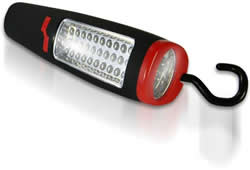Task 1.
- Read the article: The Value of Failure and be prepared to offer any comments you have in class tomorrow.
- Watch this video:
 Multimeters
for Beginners
Multimeters
for Beginners
Task 2.
 Complete these questions on the use of the Dgitial MultiMeter (DMM).
Complete these questions on the use of the Dgitial MultiMeter (DMM).- Additional Questions. Read the Engineers Canada: Code of Ethics (page 3).
- Explain the difference between Alkaline, NiCd, and NiMH battery technologies in terms of their chemical composition and reusability properties.
- Through the use of their respective datasheets, summarize the metric dimensions and weight of each of AA, AAA, and 9V batteries.
- What is meant by the term milliamp hours (mAh) and identify this value for each of the three battery sizes in Step 2.
- Research the proper ways to dispose of AA, AAA, and 9V batteries once they are used up.
- Read the Adafruit page entitled: "What is an LED?"
Task 3.
- Complete these questions in support of your First Circuit.
Task 4.
- Download the Fritzing application and create a separate breadboard diagram for each of the three LED circuits in Task 3: your First Circuit.
Task 5.
- Look at an online offer to purchase the Work Lamp we examined in class today.
 Based on discussions in class, download the Excel Workbook, AnalysisWorkLamp.xlsx and complete as many entries in the cells shaded in green and bring your partial findings to class tomorrow.
Based on discussions in class, download the Excel Workbook, AnalysisWorkLamp.xlsx and complete as many entries in the cells shaded in green and bring your partial findings to class tomorrow.- Click on the image below left to enlarge. Identify the large fixed resistor between the two switches, in particular, its colour bands. Use this resistor applet to identify the size of the resistor they used in this circuit. Does it match your calculations?
- Look at the smaller resistor along the bottom and again, identify the resistane of this component through its colour bands. Does this match your prediction?
 Complete these questions on the use of the Dgitial MultiMeter (DMM).
Complete these questions on the use of the Dgitial MultiMeter (DMM). Based on discussions in class, download the Excel Workbook, AnalysisWorkLamp.xlsx and complete as many entries in the cells shaded in green and bring your partial findings to class tomorrow.
Based on discussions in class, download the Excel Workbook, AnalysisWorkLamp.xlsx and complete as many entries in the cells shaded in green and bring your partial findings to class tomorrow.
